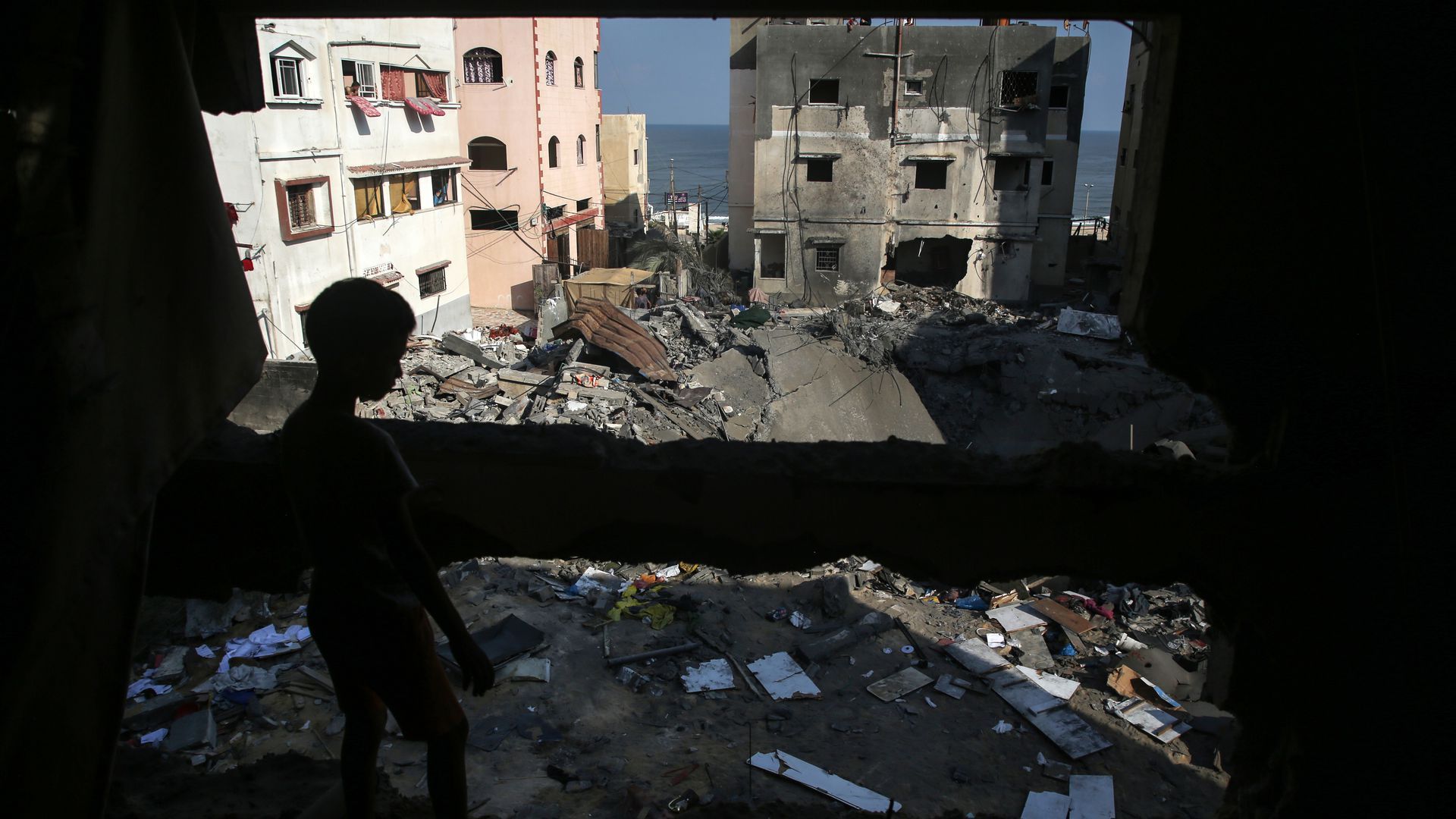| | | | | | | Presented By Global X ETFS | | | | Axios World | | By Dave Lawler · Aug 08, 2022 | | Welcome back to Axios World. - Tonight's edition (1,909 words, 7 minutes) starts in Africa with Kenya's elections and Biden's new strategy for the continent.
New arrival? Subscribe. | | | | | | 1 big thing: The fight to be Kenya's next president |  | | | Raila Odinga holds a rally in Kisumu, Kenya. Photo: Ed Ram/Getty Images | | | | Tomorrow's election in Kenya is a clash of personalities between two familiar faces: longtime opposition stalwart Raila Odinga and Deputy President William Ruto. Why it matters: Kenya's next president will have to navigate soaring food prices, ballooning debts, relations with Beijing and regional instability. Odinga, 77, is seeking the presidency for the fifth time, but after decades in opposition — and multiple stints in prison for opposing single-party rule — he finds himself in a new position: the establishment favorite. - Flashback: Odinga's 2018 handshake with outgoing President Uhuru Kenyatta rocked Kenyan politics. The president's erstwhile foe was now his ally, and his longtime deputy, Ruto, became his political nemesis.
- The terms of the Kenyatta-Odinga pact remain unclear, but many Kenyans saw it as a case of political dynasties closing ranks. Kenyatta's father was Kenya's first president, while Odinga's was the first vice president (though the former did throw the latter in jail).
- If Odinga wins, Kenyatta (who is stepping down due to term limits, and endorsed Odinga) may chair the ruling coalition. If Ruto wins, he's pledged to form an inquiry into "cronyism and state capture," which could target Kenyatta.
Ruto's campaign is centered around his humble origins as a "hustler" who hawked chicken on the streets to survive. - Ruto, 55, is more circumspect about the sources of his current wealth. Odinga's supporters chant at rallies that Ruto is a "thief."
- Ruto denies the corruption claims. A charismatic populist, he rails against the establishment and vows to elevate the poor.
Economic struggles are top of mind for voters at a time of soaring prices, high unemployment and ballooning debts. - Kenyatta borrowed heavily from China to fund infrastructure projects. Odinga wants to renegotiate some of that debt — in part so he can afford a new monthly subsidy for the poor.
- Meanwhile, Ruto's promise to deport Chinese workers won't endear him to Beijing.
- According to an Afrobarometer poll conducted last year, 87% of Kenyans think their government has borrowed too much from China.
Kenyans often vote along ethnic lines, but for the first time, none of the front-runners are from the Kikuyu ethnic group, Kenya's largest. - Both front-runners picked Kikuyu running mates. Odinga's, Martha Karua, would be Kenya's first female vice president.
- But with the role of ethnicity somewhat diluted, class may play a larger role. Polls show Ruto leading among poorer Kenyans, though Odinga is narrowly ahead overall.
What to watch: While Kenya is often seen as a beacon of stability in east Africa, the country saw widespread post-election violence in 2007 and again in 2017, on a smaller scale. - Kenya's Supreme Court annulled the 2017 results due to irregularities, but Odinga withdrew from the rerun and Kenyatta won a second term.
- This time there won't be an incumbent clinging to power, but the loser could contest the result.
- The race will go to a runoff within 30 days if neither candidate wins an outright majority, potentially heightening tensions further.
|     | | | | | | 2. Biden's new approach to Africa |  | | | Blinken lays out Biden's Africa strategy in Pretoria, South Africa. Photo: Andrew Harnik/Pool via Getty | | | | Secretary of State Tony Blinken is in South Africa today, where he unveiled the Biden administration's Africa strategy. Why it matters: One element of that strategy is not to force countries to choose between the U.S. and China or Russia. "The United States will not dictate Africa's choices," Blinken said. "Neither should anyone else." - His South African counterpart, Naledi Pandor, said during a joint press conference that some actors — though not the Biden administration — try to "bully" African countries into certain decisions, but that won't work.
- Pandor added that conflict between the U.S. and China is economically "destabilizing" and African countries must not be "made party to" it. "These are the two biggest economies in the world. They've got to find a way of working together to allow us to grow."
Yes, but: For all the rhetoric about not forcing countries to choose, Blinken's remarks came four days after UN Ambassador Linda Thomas-Greenfield warned in Uganda that buying anything from Russia other than agricultural products could lead to sanctions. - Most African countries, including South Africa, have declined to join Western sanctions or condemn Moscow's Ukraine invasion.
What's next: Blinken will head to the Democratic Republic of Congo and Rwanda to try to dial down tensions and the risk of full-scale war. - An unpublished report submitted to the UN Security Council supports the DRC's claims that Rwandan forces are working with M23 rebels to mount operations in resource-rich eastern Congo, per the FT.
- The current conflict has echoes of the devastating Congo wars of the 1990s.
Biden will host a summit of African leaders in December. |     | | | | | | 3. Data du jour: Where Biden's top team travels |  Data: U.S. government press releases; Map: Axios Visuals When we made a previous iteration of this map eight months into Biden's presidency, tracking the travels of nine senior U.S. officials, Africa was blank aside from Egypt. - This time, we're just looking at six top officials: Biden, Blinken, Vice President Harris, Secretary of Defense Lloyd Austin and national security adviser Jake Sullivan.
The big picture: Blinken has now made multiple trips to Africa and Latin America. Biden has yet to visit either region, but he has made multiple trips to Europe in addition to his visits to the Middle East and East Asia. - One surprise: None of the officials we're tracking has visited Canada, though there have been several high-level interactions between the Biden and Trudeau governments.
- Nearly all of Biden's predecessors since Franklin D. Roosevelt visited both North American neighbors, so perhaps Biden will follow suit at some point in his presidency.
What to watch: It's no surprise that Biden has yet to visit China and Russia. However, every previous president since Ronald Reagan visited both countries, with the exception of Donald Trump, who visited Beijing but not Moscow. Worth noting: For all the talk of pivoting to Asia, studying these itineraries has been a reminder of just how much U.S. diplomacy still flows through Europe. - However, this administration has made a lot of trips to Southeast Asia. For example, Blinken's Africa swing followed stops in Cambodia and the Philippines.
- There has been no shortage of travel to the Gulf, including from Biden himself. But Turkey is still blank (though Thomas-Greenfield and Blinken's deputy Wendy Sherman have visited).
|     | | | | | | A message from Global X ETFS | | The rise of cyber threats is not just a news story, it's a reality | | |  | | | | If we're lucky, cybersecurity can feel like an afterthought. But as the world continues to digitalize, more of our data and devices are potentially at risk. Explore the Global X Cybersecurity ETF (BUG) for exposure to companies preventing intrusions and attacks — all in single trade. Explore BUG. | | | | | | Bonus: Where in the world? |  | | | Illustration: Natalie Peeples/Axios | | | | Today's theme is "at the border." Can you name the countries that share the following landmarks at their borders? 1. Niagara Falls 2. Mount Everest 3. Joint Security Area/DMZ 4. Chernobyl Exclusion Zone + Polesie Radioecological Reserve 5. Lake Victoria (3 countries) 6. Darién Gap 7. Mont Blanc 8. Tierra del Fuego 9. Lake Titicaca 10. Lake Peipus Scroll to the bottom for the answers. |     | | | | | | 4. View from Taiwan: "Everyone becomes numb" to China threat |  | | | Tourists pose for a photo on the beach near Kaohsiung Harbor, as cargo ships anchor outside the Taiwanese port on Aug. 5. Photo: Sebastian Kjeldtoft | | | | LIUQIU ISLAND, Taiwan — Families collected shells on the beach and tourists took selfies at sunset on the tiny resort island of Liuqiu, less than 6 miles away from one of the "danger zones" where China is conducting live-fire military drills, Axios' Bethany Allen-Ebrahimian reports. The big picture: While international attention focuses on an emerging cross-strait crisis, the Taiwanese have been living with Chinese government threats for decades. Few people appeared seriously concerned about a possible military conflict — even on this islet, closer to the drills than any other part of Taiwan. - Divers swam with turtles close to the shore, and fishing boats traversed the nearby waters as usual. In the evenings, seaside restaurants and bars were filled to capacity.
The military drills haven't affected business, Jen Yu, a woman who works at a diving school on Liuqiu, told Axios. - The number of customers has declined slightly in the past week, Yu said, but that's because it is "ghost month," when ghosts are believed to come out of the water and curse those unlucky enough to run into them.
- Some divers were afraid of the ghosts, but they weren't afraid of China's military exercises, Yu said.
Yes, but: A few people did express anxiety about the drills and the rise in tensions between China and Taiwan. - "I feel a little nervous. It's a feeling of being squeezed," said Xie Hui-ju, a school teacher who had come to the beach with her husband and three daughters.
- Even so, Xie said she wasn't worried about an actual military conflict. "After a long time of this, everyone becomes numb to it. People think it's just words, that they won't take real action."
The latest: China has announced a new series of exercises near Taiwan over the course of the next week. |     | | | | | | 5. Cease-fire holding in Gaza after three days of fighting |  | | | A Palestinian boy inspects damage outside a residential building in Gaza City on Aug. 8. Photo: Majdi Fathi/NurPhoto via Getty Images | | | | An Egypt-mediated cease-fire in Gaza is holding after three days of fighting between Israel and the Islamic Jihad militant group left 45 Palestinians, including at least 16 children, dead and 350 wounded, Axios' Laurin-Whitney Gottbrath writes. Catch up quick: The fighting began last Friday after Israel arrested a senior Islamic Jihad member in the occupied West Bank. - Israel launched airstrikes on Gaza, saying it had credible intelligence that showed Islamic Jihad was planning to attack Israelis.
- Palestinian officials blamed Israel for the escalation.
State of play: Israeli caretaker Prime Minister Yair Lapid said Israel had killed two Islamic Jihad commanders and that while the deaths of children "is heartbreaking," Israel will "not apologize for defending its people with force." - The Iran-backed Islamic Jihad group, which fired hundreds of rockets toward Israel, also claimed "victory."
- The fighting did not draw in Hamas, which controls Gaza.
The big picture: Gaza, home to 2.3 million Palestinians, continues to face economic and humanitarian crises made worse by an Israeli-Egyptian blockade. - Israel closed border crossings last week, preventing planned fuel shipments from entering Gaza. The electricity cuts hit hospitals hard, Al Jazeera reports.
- The territory's only power plant shut down but has since restarted, and border crossings have begun to reopen for humanitarian needs.
What to watch: Egypt said it was working for the release of two senior Islamic Jihad members in Israeli detention as part of the truce. - An Islamic Jihad official warned today that the cease-fire agreement won't hold if its members aren't freed.
|     | | | | | | 6. One to watch: The ripples of Biden's climate bill |  | | | Illustration: Rae Cook/Axios | | | | President Biden's promise of American "leadership" on climate change has been undermined by quite reasonable skepticism that the U.S. will ever match words with action. - Flashback: Biden's hand at the COP26 climate conference in Glasgow was weakened by the failure of Congress to advance his climate agenda.
That has now changed. - The bill Congress passed on Sunday gives the U.S. a chance to meet its Paris Agreement targets and will bolster U.S. credibility to persuade other countries to take actions of their own, Axios Generate co-authors Andrew Freedman and Ben Geman write.
- There's a long way to go and there could be a new president in 2025. But for now, Biden can credibly claim that the U.S. is back in the game.
|     | | | | | | 7. Stories we're watching |  | | | A fire at an oil depot in Matanzas Bay, Cuba. Photo: Yamil Lage/AFP via Getty | | | - UN chief condemns shelling of Ukraine nuclear plant as "suicidal"
- Huge Ukraine arms package
- Head of Amnesty Int'l Ukraine arm resigns after backlash to report
- Rare good news for Barrier Reef
- Europe is closing gap in women's soccer
- Trump wanted "totally loyal" generals, like ones in Nazi Germany
- "Great and irreparable harm": Milley assailed Trump in draft resignation letter
Quoted: "I believe that you have made a concerted effort over time to politicize the United States military. I thought that I could change that. I've come to the realization that I cannot, and I need to step aside and let someone else try to do that." — Joint Chiefs Chairman Gen. Mark Milley in a draft resignation letter, per Susan Glasser and Peter Baker. He didn't submit it. |     | | | | | | A message from Global X ETFS | | The rise of cyber threats is not just a news story, it's a reality | | |  | | | | If we're lucky, cybersecurity can feel like an afterthought. But as the world continues to digitalize, more of our data and devices are potentially at risk. Explore the Global X Cybersecurity ETF (BUG) for exposure to companies preventing intrusions and attacks — all in single trade. Explore BUG. | | | | Answers: 1. Canada and U.S.; 2. Nepal and China (Tibet); 3. North and South Korea; 4. Belarus and Ukraine; 5. Uganda, Tanzania, Kenya; 6. Colombia and Panama; 7. France and Italy; 8. Argentina and Chile; 9. Bolivia and Peru; 10. Estonia and Russia. Key: 1. Niagara Falls; 2. Mount Everest; 3. Joint Security Area/DMZ; 4. Chernobyl Exclusion Zone + Polesie Radioecological Reserve; 5. Lake Victoria (3 countries); 6. Darién Gap; 7. Mont Blanc; 8. Tierra del Fuego; 9. Lake Titicaca; 10. Lake Peipus. |  | | Are you a fan of this email format? It's called Smart Brevity®. Over 300 orgs use it — in a tool called Axios HQ — to drive productivity with clearer workplace communications. | | | | | | Axios thanks our partners for supporting our newsletters. If you're interested in advertising, learn more here.
Sponsorship has no influence on editorial content. Axios, 3100 Clarendon Blvd, Arlington VA 22201 | | | You received this email because you signed up for newsletters from Axios.
Change your preferences or unsubscribe here. | | | Was this email forwarded to you?
Sign up now to get Axios in your inbox. | | | | Follow Axios on social media:    | | | | | |












No comments:
Post a Comment